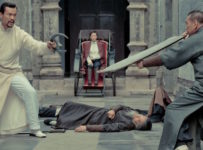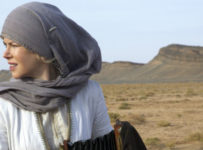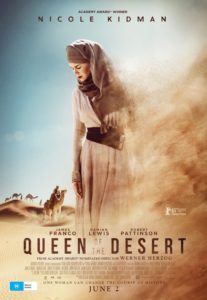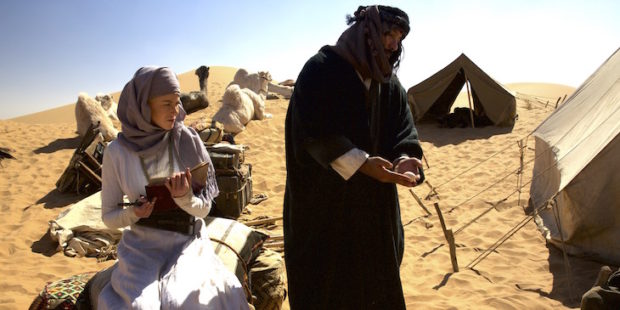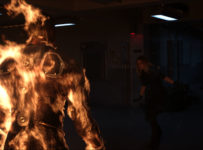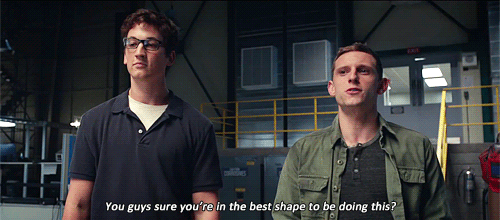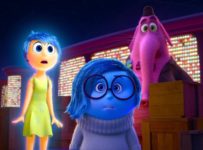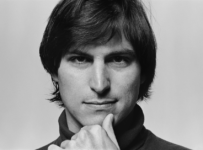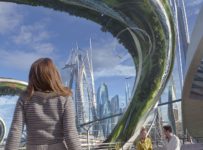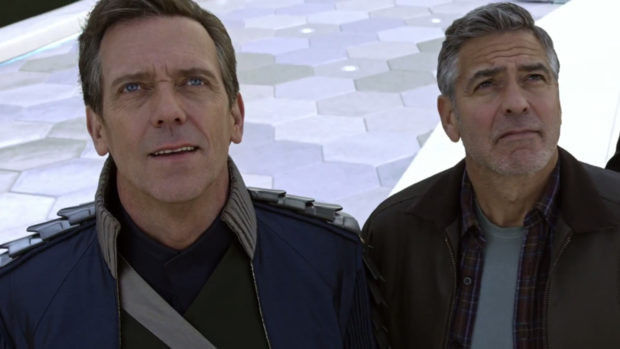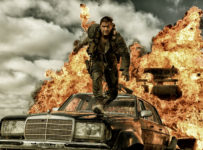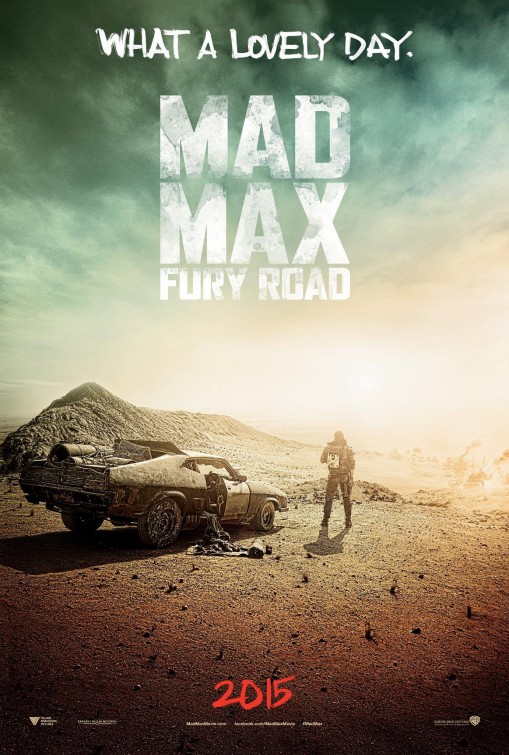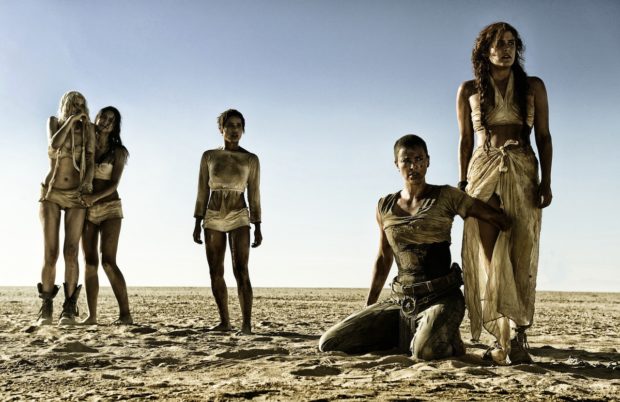The sequel to be most successful comic book film ever takes everything up several notches, and can barely keep it all inside.
[stextbox id=”grey” caption=”Avengers: Age of Ultron (2015)” float=”true” align=”right” width=”200″]
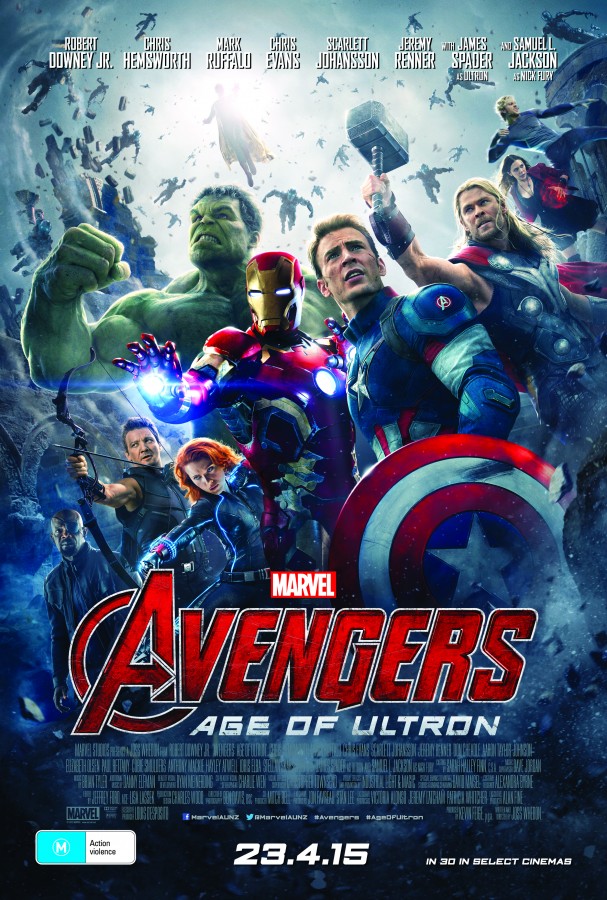
Director: Joss Whedon
Writers: Joss Whedon
Runtime: 142 minutes
Starring: Robert Downey Jr., Chris Hemsworth, Mark Ruffalo, Chris Evans, Scarlett Johansson, Jeremy Renner, Don Cheadle, James Spader, Aaron Taylor-Johnson, Elizabeth Olsen, Paul Bettany, Cobie Smulders, Samuel L. Jackson
Distributor: Disney
Country: US
More info
[/stextbox]
NOTE: This review originally appeared at our sister site, BEHIND THE PANELS. Please visit there for more comic book content, and our weekly podcast.
The coming together of geek god king Joss Whedon and the world of cinematic comic bookery was enough to make even the most cynical fan reach for his or her swooning couch, and the box office success of that union proved that superhero popularity extended well beyond the chaise longue. In the last three years, the rest of the Marvel Cinematic Universe has continued to grow in unexpected but equally successful ways, across television and mixed media, so it’s a very different landscape that AVENGERS: AGE OF ULTRON lands in.
Whedon wastes no time in throwing the audience into the action, perhaps responding to audience reactions of the slower beat of the previous film’s first act. In a refreshingly exposition free set-up, it’s evident some time has passed since the last time we saw any of these characters, as they are now a fully-fledged team on the last of a series of recon missions. Discovering not only Baron Von Strucker (Thomas Kretschmann) in possession of Loki’s sceptre, but the “enhanced” twins Pietro (Aaron Taylor-Johnson) and Wanda Maximoff (Elizabeth Olsen), they unwittingly set in motion a bigger plan, and kickstart the artificial intelligence Ultron (James Spader) to life.
It’s difficult to be too critical of AVENGERS: AGE OF ULTRON, for in every way it mostly achieves what it sets out to do by being a bigger and rompier version of its predecessor. This doesn’t begin as the origin story of a team, but rather an established group of characters interacting in a way we’ve never seen on screen before. The opening raid sequence is one of the impressive displays of superheroics ever, placing the characters in real peril and surrounding them in a swirling chaos. It’s a pace that the film rarely lets up on, with the already infamous “Hulkbuster” sequence, several Ultron attacks and a literally earth-shattering climax all coming in rapid succession.
Yet the film shows some of the weaknesses that the Avengers themselves face during their latest outing, in that the individual parts are all vying for a bigger piece of the whole. There’s a conscious decision with Hawkeye (Jeremy Renner), for example, to give him a significant amount of backstory to make up for his perfunctory role in the 2012 film. While it’s a positive step, Renner isn’t the only star in the game, and every single one of the characters is given their own arc. This may sound like a good thing on paper, and works well within the context of a monthly comic, but many of the arcs get buried in the cacophony of concurrent threads. With the multitude of storylines – not to mention the introduction of several new lead characters – it’s occasionally hard to keep track of what’s happening and it really does feel as though bits are missing between scenes. Ultron escalates from newborn to global threat in the space of a scene, barely giving us time to take in the enormity of the issue.
In many ways, Whedon is trying to ape the compressed storytelling movement of the comic book world, lurching from one scene to the next to keep momentum going while tying up as many threads as possible in a short burst. This works brilliantly until you stop and try to piece together some of the disparate scenes, such as why it was necessary to have perfunctory visits to Africa and South Korea. For this reason, the middle act feels a bit messy on occasions. Instead of developing a fuller narrative, we instead get a series of tried-and-true shortcuts: a repeated gag about Rogers swearing, a trip to a farm to recuperate after a loss, and even an evacuation sequence with both a last minute child and a dog making it onto the last ship.
Whedon’s vision is a singular one, and there is little denying that he has still got a finger placed firmly to the pulse when it comes to delivering exactly what the audience wants to see on a grand scale. Yet that also unfortunately means discarding those elements he seems to disagree with from previous films. Tony Stark’s profound decision and resolution at the end of the divisive Iron Man 3 is ignored for favour of cool new toys. Any substance in the Steve Rogers/Natasha Romanov relationship in Captain America: The Winter Soldier is dismissed in a one-liner about flirting. Indeed, the closeness of Black Widow to Clint Barton/Hawkeye that Whedon himself set up in The Avengers is cast aside for a new revelation about Barton’s personal life that feels more about plot necessity than character development.
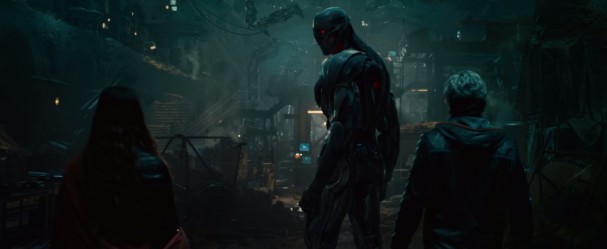
The cinematography of Ben Davis (Guardians of the Galaxy, Kick-Ass), a regular collaborator with Matthew Vaughn, replaces the sometimes cramped photography of Seamus McGarvey. This gives the film the epic look it needs, and it is a revelation to see these characters assemble in a wider scope with darker shades surrounding them. This is necessary for the introduction of the robotic Ultron, captured as one of Whedon’s sarcastic “Big Bads” by James Spader, filling the impossibly large frame with swagger and ponce. Yet it also gives newcomer Wanda Maximoff/Scarlet Witch a realistic stage to play her mind games on the team, and it’s evident by the end that Whedon may have just used this film as an excuse to bring her into the fold.
AVENGERS: AGE OF ULTRON nevertheless ends on a massively positive vibe, setting us up for the next phase via a wickedly funny mid-credits stinger, and is bookended by action sequences and liberal doses of humour that the writer/director is known for. If the middle act is a little emotionally uneven, or compressed to the point of brevity, perhaps it is through being overly ambitious. With Avengers: Infinity War planned to be two films, it is evident that the scale of the storytelling in these films is getting larger. Indeed, the first cut of this film was reportedly over 3 hours, and despite the scale, this chapter is actually slightly shorter than the first outing. It’s one of those rare instances where a longer film was justified in giving the film some breathing room, albeit it still remains a worthy romp in the end.
AVENGERS: AGE OF ULTRON releases in Australia on 23 April 2015, and on 1 May 2015 in the US, from Disney.
Want to keep up with all the latest? Got a comment? Start a conversation below, or take it with you on Behind the Panel’s Facebook and Twitter!
If you are an iTunes user, SUBSCRIBE to our weekly podcast free here and please leave us feedback. That’s how we get more attention on the Interwebs and move up the iTunes charts!
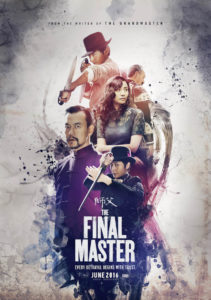 A stylish set of street fights are the highlights of this slick and sometimes overcomplicated historical martial arts epic.
A stylish set of street fights are the highlights of this slick and sometimes overcomplicated historical martial arts epic.